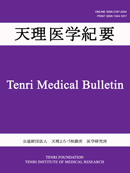Volume 21, Issue 2
Tenri Medical Bulletin
Displaying 1-7 of 7 articles from this issue
- |<
- <
- 1
- >
- >|
Original Article
-
2018 Volume 21 Issue 2 Pages 56-69
Published: December 25, 2018
Released on J-STAGE: December 25, 2018
Download PDF (6520K)
Case Report
-
2018 Volume 21 Issue 2 Pages 70-79
Published: December 25, 2018
Released on J-STAGE: December 25, 2018
Download PDF (7785K)
2017 Symposium of the Tenri Institute of Medical Research
-
2018 Volume 21 Issue 2 Pages 81-89
Published: December 25, 2018
Released on J-STAGE: December 25, 2018
Download PDF (6307K) -
2018 Volume 21 Issue 2 Pages 90-103
Published: December 25, 2018
Released on J-STAGE: December 25, 2018
Download PDF (6870K) -
2018 Volume 21 Issue 2 Pages 104-
Published: December 25, 2018
Released on J-STAGE: December 25, 2018
Download PDF (266K) -
2018 Volume 21 Issue 2 Pages 105-
Published: December 25, 2018
Released on J-STAGE: December 25, 2018
Download PDF (237K)
Pictures at Bedside and Bench
-
Article type: Pictures
2018 Volume 21 Issue 2 Pages 106-109
Published: December 25, 2018
Released on J-STAGE: December 25, 2018
Download PDF (2142K)
- |<
- <
- 1
- >
- >|
